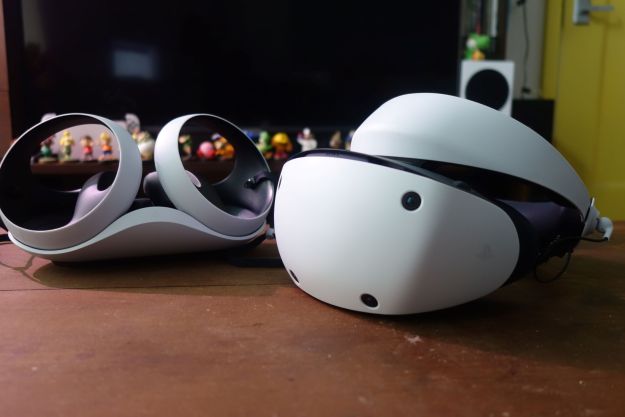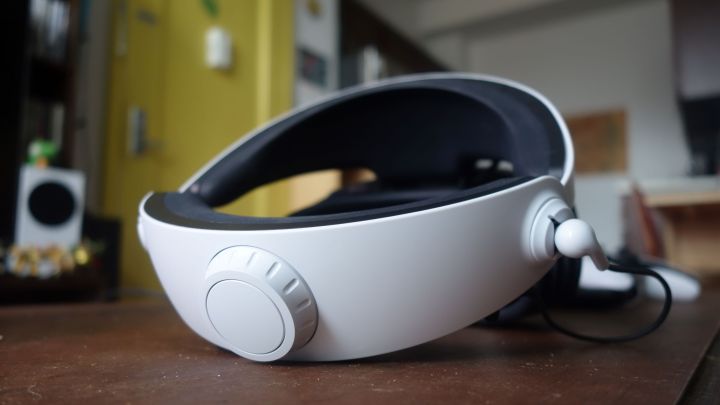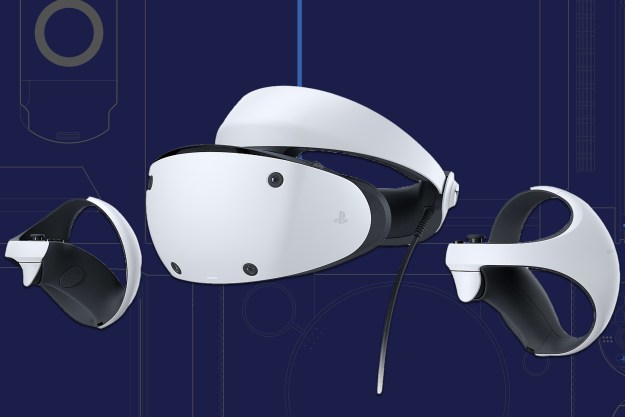
“PlayStation VR2 is a strong iteration of Sony's first VR headset, but a lack of software and direction leave its future unclear.”
- Very comfortable
- Clear display
- Excellent Sense controllers
- Improved tracking and feedback
- Competitive specs
- Bulky wired design
- Costs more than a PS5
- Lacking games and direction
I didn’t understand the true significance of the PlayStation VR2’s name until I first strapped it on.
OK, there’s seemingly not much of a puzzle to decode there; it’s the second PlayStation VR headset. It doesn’t take a genius to figure it out. But as I unboxed the device and began to see the same familiar design hallmarks that defined PlayStation’s first headset, I could quickly see why Sony opted not to brand it with a distinct name like the PlayStation Quest. The headset doesn’t reinvent Sony’s approach to VR so much as it iterates on a first draft. It’s a true hardware sequel.
That approach puts PSVR2 in a potentially polarizing spot. Those who love the first version and use it as their sole VR device will be stunned by its major technical upgrade. Brand new releases like Horizon Call of the Mountain look astonishing, and I’d wager that you won’t get a clearer picture or more comfortable experience from any other headset at its price point. Serious VR stalwarts, on the other hand, might come away with a different perspective. Its $550 price tag — double that if you don’t already own the PlayStation 5 needed to run it — is a little eye-popping when placing it next to competitors like the Meta Quest 2. Why spend the money on another headset that has less utility than a typical VR device and mostly plays the same games?
That duality makes PSVR2 an odd device to critique, as it could either be revelatory or redundant depending on who’s wearing it. As a first dive into the tech or an upgrade to Sony’s first headset, PSVR2 is an impressive evolution of Sony’s gaming gadget. Excellent specs set the stage for Sony to deliver high-end VR experiences that can diversify PlayStation’s already top-notch game library. Though when trying to predict the future, the crystal ball is currently as fuzzy as the first PSVR’s low-res display. An underwhelming slate of launch software leaves me unsure if it’ll be worth the cost of entry in the long run.
Design and comfort
When I first saw pictures of the PlayStation VR2, I was thrilled. At a glance, with little visual context, it looked like Sony had opted for a sleeker design this time around. I was very wrong. Upon taking it out of the box, I quickly realized that the PSVR2 is every bit as big as the first PSVR, if not a little larger. It has roughly the same design, with a massive segment containing its eyepiece and a hard plastic halo surrounded in thick padding. It’s fairly lightweight, all things considered, but it’s a pretty light redesign for a device that already felt a little chunky.
I was able to play Horizon Call of the Mountain for three hours straight without feeling a bit of discomfort.
Despite that initial disappointment with its size, all of its little improvements are much needed across the board. That’s most apparent in the mechanisms for fitting it on one’s head and adjusting it. I could never really get a clear picture out of the first PSVR and would always find myself fiddling with it while playing. The PSVR2 puts a lot of work into solving that problem with a three-step system. A button on the eyepiece pulls back the headband to make it easier to place on my head. I then press a second button on the back to loosen the headband and properly fit it and push the eyepiece back in place when I’m done. From there, I can turn a dial on the back of the headband to get the tightness just right, which is much easier to control than the hard wheel of the previous model.
While I struggled to get the right fit at first, I quickly realized I was overthinking it due to how cumbersome previous devices were. Once I found the right position, I found that the headset was exceptionally easy to put on and keep on. What surprised me most is how comfortable it is once it’s there. The padding around the headband is quite soft, though it does still leave a bit of “VR face” on my forehead (though worse are the marks on my nose, which can look particularly nasty if I’m locking it in too hard). Even so, I was able to play Horizon Call of the Mountain for three hours straight without feeling a bit of discomfort. By comparison, I often have to tap out from my Meta Quest 2 after an hour due to how much it feels like it’s squeezing my brain out of my head.
PSVR2 goes the extra mile in a few other small areas, which I quickly grew to appreciate. A dial on the eyepiece allows me to adjust the lens distance on the fly, which does wonders for clarity. With the first PSVR, I’d have to struggle to find a balance between the clearest image and the most comfortable fit. I no longer have to do that with PSVR2. Once I find my most natural position, the lens tool makes sure I don’t have to compromise.

As far as iterations go, I’m also pleased with how Sony has changed up its audio. The original model had built-in earbuds that were always attached to the headset. They could be docked to the sides when not in use, but I often found them popping out, which led to some unsanitary situations. That same approach is still present here, but Sony has made the earbud unit removable this time. The buds now sit on a thin ring unit that can be attached underneath the headset through a 3.5mm jack. When in, they function just like on the first headset. If I don’t want to use them, however, I can take the unit off entirely and use my own headphones or none at all.
Audio is the one area where I start to notice how behind the curve (or just on the edge of it) Sony is, which becomes a bit of a running theme the more I test. The headset doesn’t have any form of built-in audio, unlike the Quest 2. While that’s certainly not a deal breaker, it does reinforce the idea that PSVR2 isn’t necessarily keeping pace with the wider tech landscape and is operating in Sony’s own VR vacuum. It’s a step forward for PlayStation owners, but not necessarily VR as a whole.
Setup
That dynamic is present in the system’s setup process. If you’ve only used PSVR to access virtual reality at this point, the new version will feel like a sigh of relief. While the old headset connected to PS4 via a complicated processing unit and multiple cables, PSVR2 is a one wire system. Plug it into the PS5’s USB-C port and that’s it. Considering that I skipped various PSVR games over the years because I just didn’t feel like dealing with all the wires, the new system is a godsend when it comes to ease.
Going back to a wired connection feels a little restrictive, but I’m ultimately not too bothered by it.
Of course, the downside is that it’s still a tethered connection in a world where wireless is gaining ground. Over the past few years, I’ve come to love the freedom of the Quest 2, as it allowed me to freely move around my larger bedroom to play games like Half-Life: Alyx (I sideloaded it to get it working wirelessly, and it’s the best gaming decision I’ve ever made). Going back to a wired connection feels a little restrictive, but I’m ultimately not too bothered by it. Ultimately, the headset is powered by the PS5, so some sort of connection was needed. The fact that Sony made that setup so easy makes me willing to live with it — especially with the extra comfort.
One area where Sony does keep up with competitors is via a dedicated passthrough button right next to the system’s power button. At any time, I can press this to see my real surroundings in black-and-white. That feature is a major improvement for Sony’s VR as it makes it much easier to figure out where I am when I’ve suddenly wandered out of my designated play area, or when I’m trying to make sure my cat doesn’t get in my range of movement when I’m least expecting it. It’s a much-needed technical addition that makes sure PSVR2 doesn’t feel entirely out of step with where the tech is moving.

Sony has also improved how users create play areas, further taking notes from its peers. When I first set up the headset, creating a very quick play area, I found myself bouncing out of bounds frequently. I was frustrated for a moment, until I realized I could freely edit that area at any time. By using the controllers to literally draw a boundary around my living room with passthrough tech, I could sketch out a much bigger area. Since then, I haven’t bumped up against the edge of the play area at all, keeping me immersed. It’s incredibly simple and reduces another disruption that can cut into VR’s immersive magic trick.
Controllers and feedback
The biggest change here is how the device handles controls. Previously, the PSVR supported the standard PS4 controller in most games, as well as Sony’s Wiimote-esque Move controllers. Sony has simplified matters here by bundling its new Sense controllers in with every headset, and they act as the platform’s sole control scheme. Sony basically splits its DualSense in half here, putting one side of it in each hand. Each controller has its own trigger, bumper, joystick, home button, and two face buttons. The left includes the standard PlayStation share button, while the right has a menu button, which can be held down to recenter the screen. All of that is surrounded in a protective dome to stop players from accidentally punching a wall or their own face.
Having two free hands makes much more sense in VR …
The design here once again takes cues from devices like the Quest 2 — and that’s mostly for the best. Having two free hands makes much more sense in VR, and I’m happy to be rid of the Move controllers with their inconsistent tracking. By comparison, the Sense controllers function with way fewer hitches thanks to the four cameras on the front of the headset. They also conform to my hands very naturally and are so lightweight that I don’t feel strain when tossing them around in games like Altair Breaker.
What Sony really brings to the table here is its unique DualSense tech, which makes its way into each controller. Both feature haptic feedback and adaptive triggers, which are a great fit for the immersive nature of VR. Almost every benefit I’ve mentioned so far comes together in Kayak VR: Mirage of all games. In that title, the Senses are used to control a kayak paddle. Tracking is incredibly accurate here, with the paddle precisely moving to my movements and even detecting the speed and depth of my swings accurately. Each time I drip a paddle into the water, I get a nice hit of haptic feedback that simulates the feeling of an object dipping into water. It’s an excellent sensation, allowing me to truly get lost in the experience.

PSVR2 does include some additional feedback, as well with a bit of vibration in the headset proper, which adds a nice extra touch. The main place I noticed it was in Gran Turismo 7, as my headset would rumble when I crashed into a wall. More impactful, though still subtle, is its eye-tracking, which users will calibrate when they set up the device. That allows me to easily navigate through menu options in some games by looking at them, for instance. Those extra layers work in tandem with the Senses to really keep players in the zone.
The only issue here is battery life. My Sense controllers tend to drain in four or five hours, which feels short — granted, I can’t imagine it’s healthy to spend much more time than that in VR. I do appreciate, though, that the Sense controllers are easy to charge via USB-C. That gives them a big advantage over my Quest 2 controllers, which eat batteries like it’s their job. Those who want to spend the extra $50 can also buy a handy recharging mat that makes the process easier (though I did experience some issues with controllers not locking into place as easily as I’d hoped, leading to some unexpected charge fails).
I’ll offer one more nitpick here: these things are weirdly difficult to grab on to by touch alone. When I’m trying to pick them up while in VR, I end up fumbling around the round structure and struggling to find the correct grip. It doesn’t help that the safety straps come out from the inside of the hand guard rather than the edge of it. That means that I’ll often feel them popping out of the wrong side of the controller, which ends up confusing me as I grip the wrong side. Thankfully, the passthrough button alleviates that, but the design feels just slightly off here.
Specs
Where PSVR2 really works to justify its price point is in its impressive specs. While the headset’s design sticks close to its predecessor, the guts position it as a truly “next-generation” device. The panel resolution here is 2000 x 2040 per eye, up from PSVR’s 1920 x 1080. That makes a major difference. Where Sony’s last headset was grainy and low-res, its new one offers an incredibly clear image that beats the Quest 2.
Sony makes sure that it doesn’t go to waste either by using an OLED display that looks fantastic, with refresh rates up to 120Hz. On top of that, the headset has a particularly impressive field of view (FOV) at approximately 110 degrees. That blows away most headsets within its price range, including the Quest 2 with its 89 degree FOV.

Of course, Sony’s real advantage here is the PS5. Since the headset runs off the console, that opens the door for some truly high-end experiences. I noticed the difference when I played Horizon Call of the Mountain followed by a series of ports that weren’t originally made for PSVR2. The former is one of the best-looking VR games I’ve seen in the tech’s life span, with vast landscapes, meticulously detailed enemies, and a wide range of vibrant colors.
Gran Turismo 7‘s VR view is similarly impressive, as little is lost when I switch between the headset and my TV. The TV image seems a little more detailed and with stronger contrast, but the VR view doesn’t feel like much of a compromise. When games are using the system to its full capabilities, Sony proves why it’s in a unique position to create a high-end consumer headset.
I wish I could say more about the specs here, but the reality is that I haven’t had many opportunities to see what the device can do. That speaks to a more existential problem that haunts PSVR2 right now.
Software
Initial gaming hardware reviews can be difficult because you’re always reviewing from a limited selection of launch games. When we reviewed the Xbox Series X, we initially called it a “sports car with no gas” due to its weak launch lineup that mostly relied on ports — a problem that’s been improved upon, but not entirely rectified in two years. PSVR2 finds itself in a very similar situation at launch, but I’m much less confident about how well it’ll overcome its software woes.
The launch lineup for PSVR2 creates another weird situation that’s dependent on the user’s previous familiarity with VR. If you’re entirely new to the tech, as I figure many people will be, there’s a lot to dig into. In addition to Horizon Call of the Mountain and Gran Turismo 7 VR support at launch, the headset is getting a whole host of VR hits. Games like Moss: Book 2, What the Bat?, Demeo, and more help round out its lineup and make sure that there’s a lot for newcomers to dig into.
For perhaps the first time in PlayStation’s hardware career, Sony created a piece of tech that’s operating at a disadvantage.
If you’re looking for new games built for PSVR2, though, that’s a different story. During my testing, I struggled to find much that I couldn’t (or hadn’t already) played on Meta Quest 2 or even the original PSVR. Gran Turismo 7 is the most fun exclusive you can find at launch, but it’s not so much a full-fledged VR game as an added camera option. The VR view only triggers in the middle of a race’s starting countdown; the rest of the game just displays on a flat screen within the headset. Still, I imagine it’ll be the primary way I play the game from now on as it makes the driving simulator feel that much more realistic.
Other than that, the exclusive options are underwhelming. Horizon Call of the Mountain is a solid tech test, but I was a little underwhelmed with it as a standalone game. It’s not quite the big first-party launch game I was expecting, as it can’t quite find a balance between the limitations of VR gaming and Sony’s cinematic ambitions for its biggest franchises. As a first voyage, it leaves me a little nervous that Sony still hasn’t grasped what kinds of games work best in VR.

I wouldn’t be surprised if The Last of Us or God of War gets a similar treatment to Horizon down the line, but I can’t say I’m excited about that idea right now. The platform just doesn’t have a Half-Life: Alyx, or even an Astro Bot: Rescue Mission, that really capitalizes on the device at the moment. And what’s even more of a problem is that we don’t even know what’s next. Sony says over 100 games are in development for the platform, but we have no idea what the next exclusive to watch for is. That’s not a great feeling to have when dropping $550 on a game system.
Outside of Horizon, my initial tests were far more scattershot. I had trouble getting into the enhanced edition of Star Wars: Tales from the Galaxy’s Edge, which felt like a relic next to a more modern game. Comparatively simplistic visuals and systems, as well as issues setting a proper height, had me feeling like I was running an original Xbox game on an Xbox One. I had similar reactions when popping into other titles. Sony previously spotlighted anime sword-fighting game Altair Breaker in a blog post, but I was disappointed to find a somewhat bare-bones hack and slash. The same was true of games like Cities: VR and Kayak VR: Mirage, two perfectly fine virtual toys that don’t offer much depth. None of these games give me a sense of the headset’s power or potential, as anything worth playing runs on other headsets already.

I know this is going to change — or at least, I’m assuming it will, in good faith. More complex, fulfilling games will come to PSVR2 over the course of its life span as developers get more time to work with the hardware. The way the launch was handled here, though, tells me that I shouldn’t expect a wealth of experiences like that any time soon. If even Sony is struggling to crack what a big, blockbuster VR game looks like at this stage, I imagine it’s going to be slim pickings when it comes to system-selling exclusives. I expect the bulk of its best games to be cross-platform ones that one could play on the cheaper and wire-free Meta Quest 2.
All of that leaves PSVR2 in a very awkward space that Sony isn’t used to with its PlayStation brand. For perhaps the first time in the company’s hardware career, it created a piece of tech that’s operating at a disadvantage. Even the first PSVR headset had an edge on the competition due to its low price point and a consumer-friendly strategy that didn’t exist at the time. Its successor doesn’t have those same factors in its corner, especially considering that it costs more than the more appealing console that powers it. Not only that, but it’s strictly a gaming device, whereas something like a Meta headset can do much more for much less.
The PSVR2’s power, clear display, and immersive controls are truly exciting, but none of those are going to matter if there aren’t new killer apps to make great use of it. That’s the challenge Sony has ahead as it doubles down on VR. It created a great headset I’ll be thrilled to strap into any time, unlike the company’s previous model. I’m just left with the sense that I’ll be cleaning a lot of dust off it between uses.
Editors' Recommendations
- Best PlayStation Plus Deals: Save on Essential, Plus and Premium
- The most common PSVR 2 problems and how to fix them
- PlayStation Spring Sale: best deals, how long is the sale, and more
- Best PlayStation deals: PS5, controllers, headsets on sale
- PlayStation VR2 production reportedly paused by Sony





